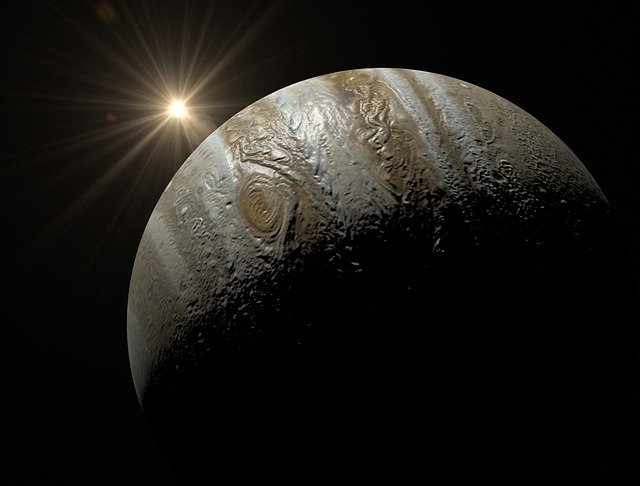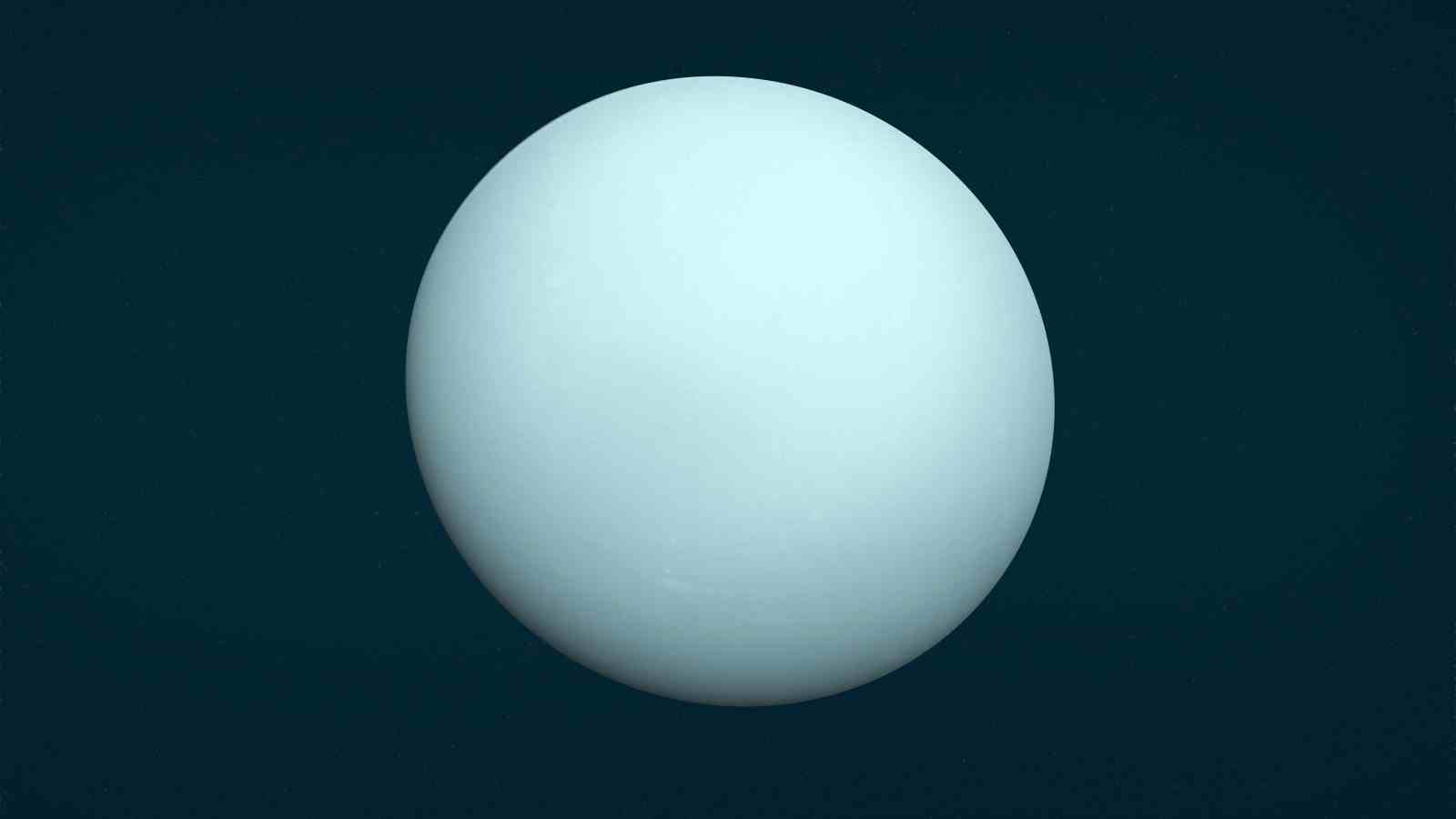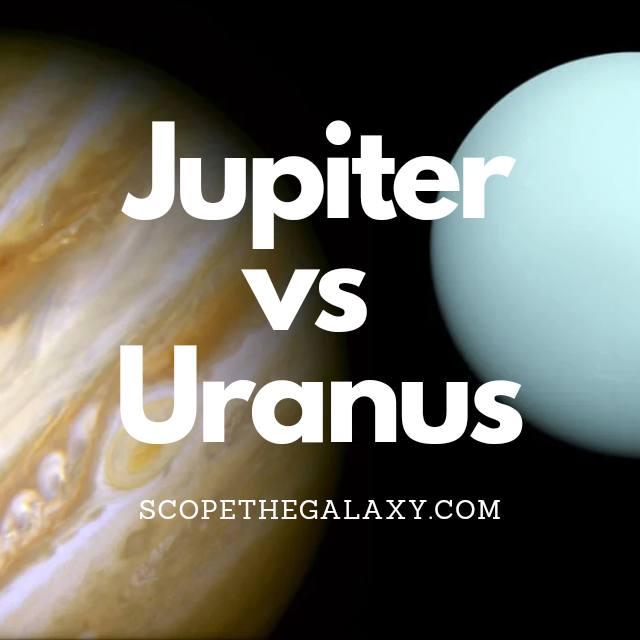*This post may contain affiliate links. This means we may make a commission if you purchase an item using one of our links*
Jupiter is the 5th farthest planet from the Sun and is the largest gas giant and planet in our solar system whereas Urnaus is the 7th farthest planet from the Sun, the biggest ice giant and the 3rd biggest overall planet in the solar system. Jupiter is mostly a dark and light brown color whilst Uranus is cyan blue, Jupiter has 79 moons whereas Uranus only has 27.
They are also similar in a variety of ways whether it be their shape, gaseous composition, how they both orbit the Sun and so on. For a more detailed breakdown of more of the similarities and differences between these two giant planets, continue reading.
What Is The Planet Jupiter?
Table of Contents

Jupiter is the 5th farthest planet from the Sun and the largest planet within our local solar system. The planets most recognisable traits is the giant red spot visible on its atmosphere along with the brown horizontal bands flowing across its being.
Jupiter falls under the classification of a gas giant. This is because its composition mostly consists of the elements hydrogen and helium. The split is roughly 71% hydrogen, 27% helium, with the remainder of the elements split throughout the left over 2%.
As the biggest planet in our solar system, Jupiter is 139,820 km or 1,300 Earths in diameter, it has a mass of around 0.001 solar masses, the temperature when inside the clouds are roughly -145 degrees celsius whilst the core is far hotter, equating in the region of 24,000 degrees celsius.
Due to its extreme circumstances, gaseous composition and distance from the Sun, the planet is not theoretically capable to support life, from its subzero temperature to the extremely fast 400mph winds, and its gravity which may be unsustainable for our bones, roughly 2.4 times greater than Earth’s.
Although the conditions on Jupiter aren’t suitable for us, some of its 79 moons like Europa for example could support life.
This brown giant has a relatively fast rotation around its axis where 1 rotation typically takes 10 hours to make whilst its orbit around the Sun is far longer taking in the region of 12 years for 1 full cycle.
Another feature of Jupiter that is renowned by astronomers is the strength of its magnetic field. In comparison to the other planets in our solar system it is even stronger than our Sun, where it’s over magnetosphere is roughly 20,000 times the strength of Earth.
What this means is that Jupiter’s magnetosphere is able to avert solar winds that are 3 million kilometers away from it.
What Is The Planet Uranus?

Uranus is the 7th farthest planet from the Sun and the 3rd largest planet in our solar system, coming in at a diameter of 50,724 km. This means that roughly 63 Earth’s could fit inside this ice giant.
In regards to why this cyan blue planet is referred to as an ice giant, it’s down to it’s composition. Uranus is made mostly of methane, ammonia and water with its atmosphere mostly consisting of hydrogen and helium, much like the Sun, and the other giant planets in our solar system.
Due to its distance from the Sun, it takes Uranus 84 years to complete one orbit around the Sun, whereas it’s axial rotation is much faster than even our Earth at 17 hours per rotation.
As a result of its distance from the Sun, ice based composition and faster rotation levels, Uranus is far from an ideal place to live in or even have the potential to support life.
Its base temperature is generally a chilling -190 to -200 degrees celsius and its rocky core, although hot, is still on the cooler side for a large planet sitting around the 5,000 degrees celsius range.
The planets winds are also very fast often hitting 900 km/h, which is roughly twice that of Earth’s most powerful turbulent wind speeds.
In regards to the moons present surrounding this cyan planet, we’ve discovered 27 small moons orbiting it. Furthermore, it has 13 rings surrounding it which also means Uranus has the most abundant collection of rings surrounding in our solar system, which is even more than Saturn.
One of the Uranus’ most unique features would include the manner in which it rotates around its axis. As opposed to the slightly angled rotation that the likes of Earth, Saturn and most other planets display, Uranus’ axis is positioned at a 98 degree angle.
What this means is this ice giant completes an axial rotation on its side as opposed to the relatively up straight positioning of most of the other planets in our solar system.
Similarities Between Jupiter And Uranus
Jupiter and Uranus have a number of similarities as they are present in the same solar system. This would include the following:
- Both planets have an atmosphere generally composed of hydrogen and helium.
- Both planets are orbiting the Sun.
- Both have hotter central core.
- Both have multiple moons.
- Both have rings around them.
- Both are a spherical shape.
Differences Between Jupiter And Uranus
In regards to the differences between these 2 giants, they would include the following:
- Jupiter is far bigger than Uranus. Jupiter could theoretically allow 1,300 Earths to fit inside it whereas 63 Earth sized planets would fit inside Uranus.
- Jupiter has 4 rings whereas Uranus has 13.
- Uranus has 27 moons whilst Jupiter has 79.
- Jupiter is much heavier than Uranus where the former is nearly 22 times heavier.
- Jupiter has temperature of -145 to -150 degrees celsius with its core roughly 24,000 degrees celsius whereas Uranus is much colder with an average temperature sitting around the -200 degrees celsius and core temperature around the 5,000 degrees range.
- Uranus has wind speeds that are much faster that Jupiter exceeding 900 km/h whereas Jupiter’s wind speeds are 640km/h.
- Jupiter is roughly 4.6 billion years old whereas Uranus is 100 million years younger at 4.5 billion years.
- As the 7th farthest planet from the Sun, it takes Uranus 84 years to complete one orbital cycle whereas Jupiter completes a single orbit around the Sun in 12 years.
- Jupiter completes a rotation around its axis every 10 hours where Uranus does so every 17 hours.
- Uranus has an axial tilt of 98 degrees to the right. Jupiter on the other hand has far lesser tilt at 3 degrees to the right.
- Jupiter has the strongest magnetic field in our solar system where it stands at 4.3 gauss. Uranus’ gauss strength is only 0.23.
- Jupiter is the denser of the 2 planets.
Summary
Although both are similar in a variety of ways, they are still very distinct in how they operate from the differences in size, temperature, composition, their orbital cycle around the Sun and even their axial tilt.
So, despite the odd few similarities the two may have, they are still very unique entities in their own right.

